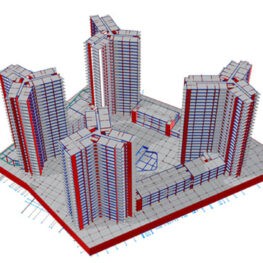
This training program, designed for civil and structural engineers, is exactly crafted to guide participants in mastering the Protastrure’s application for real-world projects while also exploring its capabilities. Throughout the training, participants will immerse themselves in the details of Protastructure, gaining hands-on experience in creating accurate 3D models of buildings. Whether starting from architectural drawings in REVIT or modelling from scratch, our course ensures a smooth transition from conceptualization to final detailing without the need for additional software, offering a streamlined and efficient design process.
A cornerstone of our training is the in-depth exploration of Protastructure’s dynamic analysis capabilities, empowering engineers to evaluate structural responses to seismic, wind, and dynamic loads. This unique focus provides participants with crucial insights into optimizing designs for
maximum efficiency and safety, setting them apart as experts in the field. The course places a strong emphasis on practical application, guiding engineers through the use of Protastructure to design
individual structural components such as columns, beams, and slabs. By incorporating international
design codes and regulations, participants ensure that their structural designs comply with industry
standards, creating a robust foundation for safe and efficient projects.
INSTRUCTORS:

Adolphe MUNEZA
ASSISTANT TRAINER / CIVIL AND INFRASTRUCTURE DEPARTMENT
Foundation design, a critical aspect of structural engineering, is comprehensively covered in our training. Participants will utilize Protastructure’s tools to analyze soil properties, determine bearing capacity, and design both shallow and deep foundations, seamlessly integrating these elements into the overall structural model.
Seismic design principles take center stage in our course, as engineers learn to effectively evaluate the seismic response of buildings and design structural elements accordingly. The focus extends beyond theoretical principles to practical considerations, such as reinforcement detailing and factors like ductility and energy dissipation, ensuring structures are resilient against seismic forces.
For construction companies, The software’s intuitive interface and robust capabilities streamline 3D modeling, advanced structural analysis, and detailed design calculations, enabling teams to deliver safe and optimized structural solutions in a collaborative environment.
Beyond the technical aspects, our training delves into Protastructure’s capacity to generate detailed structural documentation and reports. Participants will acquire skills in creating comprehensive drawings, material schedules, and essential documentation vital for effective construction and communication with stakeholders.
Here is what you can expect at the end of this training:
Joining our RC structural design and analysis training using Protastructure offers a myriad of benefits for civil and structural engineers:
1. Participants will acquire advanced skills in structural design and analysis using Protastructure, enhancing their proficiency in handling complex projects.
2. The training focuses on automating design operations, enabling engineers to streamline their processes and deliver projects more efficiently.
3. For engineers relying on manual or spreadsheet-based methods, the training provides a
smooth transition to a comprehensive and automated structural Building Information
Modeling (BIM) solution.
4. Participants will gain insights into creating accurate 3D models, performing dynamic analyses, and optimizing designs, leading to improved project delivery and structural integrity.
5. The training incorporates comprehensive design codes and regulations, ensuring that the
structural designs align with international safety and performance criteria.
6. The training covers foundation design, including soil analysis and bearing capacity
determination, ensuring stability and robustness in structural foundations.
7. Participants will learn to generate comprehensive structural documentation, including
drawings, schedules, and reports, streamlining the communication of design intent with
stakeholders.
8. The course includes practical projects and case studies, allowing participants to apply learned concepts to real-world scenarios, enhancing their problem-solving skills.
Overall, joining this training is a valuable investment in professional growth, empowering engineers to excel in their roles and contribute effectively to the evolving landscape of structural design and analysis.
Who should attend this training:
Our training program in RC structural design and analysis using the Protastructure is specifically designed for only civil and structural engineers falling into the following categories:
1. Site Civil/Structural Engineers Shifting Career Focus: Individuals with a background in civil or structural engineering with experience on construction site, seeking to transition their career focus to technical design operations, will find this program tailored to their needs.
2. Engineers Relying on Manual or Spreadsheet-Based Design: Civil and structural engineers who normally do manual or spreadsheet-based design and calculations for project delivery will benefit significantly from this training. The training aims to equip them with the tools and skills needed to transition to more advanced and efficient methods.
3. Engineers Experienced with Other Software: Professionals well-versed in other structural design software like Prokon, Etabs, etc., who are looking to adopt an all-in-one and automated structural Building Information Modeling (BIM) solution, will find this training instrumental in expanding their skill set and transitioning to a more integrated approach.
This training is structured to address the unique needs and aspirations of professionals in these categories, providing them with the knowledge and expertise required to proficiently use Protastructure for RC structural design and analysis.
